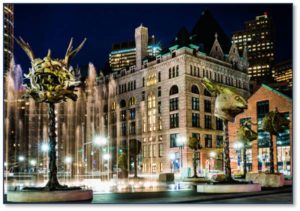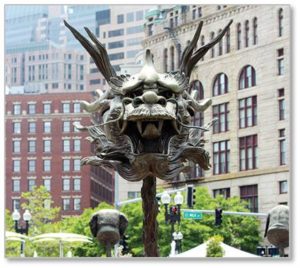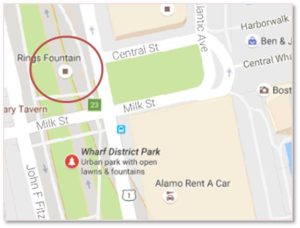This is the 15th post in my series about Boston’s Bronze Menagerie.
Boston’s lively and ever –expanding Chinatown has an interesting history and many fine restaurants. (You can explore the history with Boston By Foot on the May Tour of the Month.) What it doesn’t have is a dragon. Oh, there are dragons on posters and dragons in neon signs. Look carefully and you can find some painted ones in murals and street art that decorate the sides of buildings.
Still, Boston lacks a big, powerful dragon statue and that’s too bad because Chinese dragons control water, rainfall, typhoons and floods. If ocean levels rise due to climate change, we’re going to need all the help with flooding that we can get. A dragon would give us some real firepower against sea level rise.
Perhaps our Puritan heritage makes us look askance at mythical creatures and find them less compelling subjects for statues than, say, sports figures and politicians. Currently Boston two dragons, though. One is just visiting while the other is a much gentler version that lives far south of Chinatown.
Dragon of the Zodiac Heads
If you’re looking for a big impressive sculpture, the kind of dragon that makes a statement about power, strength, and good luck, you can find one as a temporary resident in the installation, “Circle of Animals/Zodiac Heads” by Ai Weiwei. It’s on the Rose Kennedy Greenway in the linear park’s Wharf District around the Rings Fountain.
Twelve enormous bronze animal heads represent the 12 signs of the traditional Chinese zodiac in order: Rat, Ox, Tiger, Rabbit, Dragon, Snake, Horse, Goat, Monkey, Rooster, Dog and Pig. Mounted on poles, each statue stands 10 feet tall and they range from 1,500 to 2,100 pounds. The installation stays on the Greenway until October of this year, which is the year of the Monkey. The last Year of the Dragon was 2012 and we’ll have to wait until 2024 for the next one.
Although the only imaginary animal in the Chinese zodiac, the dragon is the most vital and powerful of the twelve beasts. Dominant and ambitious creatures, dragons have sharp tongues and hot tempers. They employ their intelligence to handle challenges and take risks, although—fair warning—they do not tolerate criticism.
The artist tells us that he modeled Circle of Animals/Zodiac Heads on 12 bronze animal statues that once stood at the Yuanming Yuan, or the old Summer Palace, in Beijing. French and British troops looted the palace during the Second Opium War in 1860 and the heads were stolen. Mr. Weiwei’s reinterpretation is a commentary “to the issue of looting and repatriation of art treasures.”
In this installation, Ai Weiwei has created a particularly dramatic dragon head, one that glares at us from his high perch with mouth agape, sharp tongue curled and teeth bared. This dragon wouldn’t be afraid to confront rising sea levels and turn back the tide. Boston deserves a dragon as fierce as Ai Weiwei’s creature and it’s too bad that we can’t keep such a powerful beast here when the traveling installation moves on this fall.
The Dorchester Dragon
Lacking that, we have another full-time dragon but he’s smaller, not so scary and much closer to the ground. Named Fuku-Riu, or “Lucky Dragon,” this one eight feet long and inhabits a playground on Nonquit Street in Dorchester. Created by sculptor Nancy Schön, who also did The Tortoise and the Hare in Copley Square and Make Way for Ducklings in the Public Garden, Fuku-Riu may remind you of the imaginary beasts you see in children’s books.
According to Ms Schön, Fuku-Riu possesses a number of special characteristics:
- The large lump on his head, a poh-shan, enables him to fly, although few people have actually witnessed this activity. Fuku-Riu stays pretty close to the ground.
- The little beak at the bottom of his jaw indicates that he is a vegetarian, and thus no threat to cats, dogs, or other small creatures.
- A precious gem called a “dracontia” in the middle of his forehead gives magical powers if rubbed three times. Clearly many of Dorchester’s children have gotten magic from Fuku-Riu’s dracontia.
- His eyes stay open even at night to watch for danger and ward off threats.
- He puts his intellect to work reading, as indicated by the stacks of books scattered around him.
- The 15 bony plates along his back and tail have rounded edges and grow far enough apart so that children can fit comfortably between them.
- Instead of being barbed, his tail is heart shaped to indicate his friendly nature.
Fuku-Riu provides children with a smooth back on which to climb, sit, or ride. He also loves families.
Information and Directions to Boston’s Dragons
Both statues are in public parks that are free and open all day.
Circle of Animals/Zodiac Heads is located in the Wharf District of the Rose Kennedy Greenway between High Street and Milk Street. Take the MBTA Blue Line to the Aquarium Station and then walk south along the Greenway to the Ring Fountain.
Parking is available but expensive in the many private lots and hotels along Atlantic Avenue. It’s cheaper on the weekend when you can take advantage of garages that offer one rate for the whole day.
Fuku-Riu lives in the Nonquit Street Green at the corner of Dudley Street and Nonquit Street. Take the MBTA’s Silver Line to the Dudley Street Station and walk south until you come to the corner of Nonquit. Look for parking on the street.





